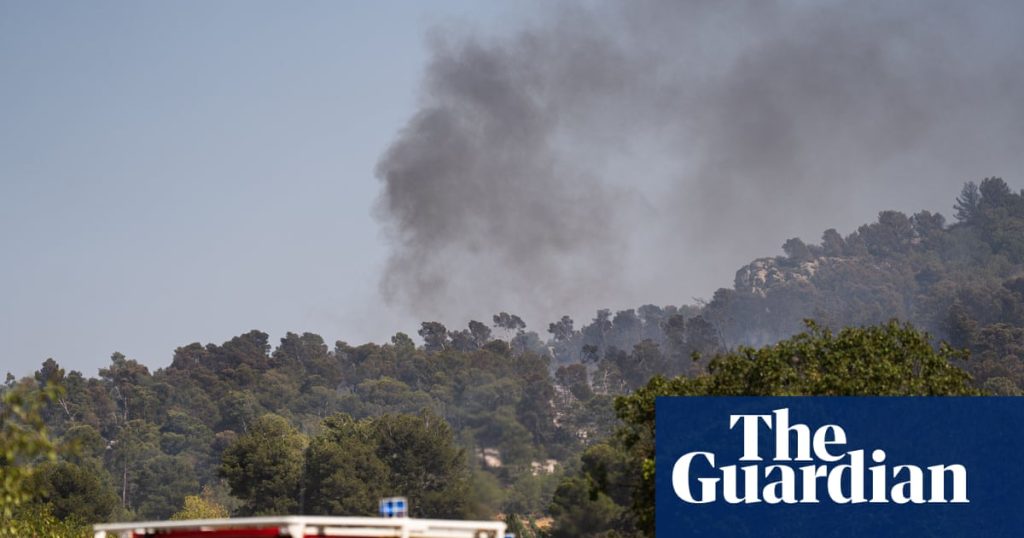Deadly heat of up to 42C is searing southern Europe, as scientists warn of a “molotov cocktail” of climatic conditions that is fuelling vast wildfires across the Mediterranean.
Météo-France placed more than half the country under heatwave warnings on Monday morning, with 12 out of 96 administrative units on the mainland under the highest red alert, while Spain’s Aemet warned of “extreme danger” in Zaragoza and the Basque Country as it issued yellow and orange warnings for almost all the rest of the country.
Both weather agencies forecast temperatures above 40C over the coming days and called for vigilance amid forecasts of “a very intense, even exceptional” heatwave in parts of the continent.
The high temperatures have alarmed experts as firefighters struggle to contain destructive wildfires. In France, which brought its biggest fire since 1949 under control on Sunday, authorities reported that one person had died in the blaze, while 20 firefighters and five civilians had been injured.
In Italy, where temperatures of 40C are expected to hit Florence on Wednesday, tourist trails were closed on Mount Vesuvius on Sunday as firefighters fought a blaze on the slopes of the volcano.
In Spain, fires that broke out in León and Zamora on Sunday forced more than 1,000 people to flee their homes, while large fires continued to burn in Galicia.
Cristina Santín Nuño, a fire scientist at the Spanish National Research Council, said the large number of blazes was “to be expected” after a wet spring that helped plants grow was followed by extreme heat, strong winds and long periods without rain.
“If we add to this the relatively easy possibility that a spark can ignite a fire somewhere … we have all the ingredients for the ‘molotov cocktail’ we’re seeing right now,” she said.
French forecasters said heat records were likely to be broken on Monday and Tuesday as temperatures pass 42C in the south-west. Temperatures hit a record high of 41.4C in the village of Tourbes, near Béziers, at the weekend.
In Spain, temperatures on Monday were expected to rise further in the Ebro basin, the southern and eastern thirds of the Iberian peninsula, and the eastern Cantabrian Sea. They were forecast to fall in the north-west, particularly in Galicia.
The weather agency said it expected heat of 37-39C across the interior of the Iberian peninsula on Monday, with maximum temperatures above 40C in the interior of the Basque Country and highs that could reach above 42C in the lower Guadalquivir.
Jesús Santiago Notario del Pino, a soil scientist at the University of La Laguna, said conditions of “extreme and prolonged heat” had primed the large number of fires across the country by drying out fuel.
He added: “Areas in the centre and north-west, theoretically less prone to severe fires – compared with the Mediterranean coast, for example – are burning. This is striking to me.”
Sign up to This is Europe
The most pressing stories and debates for Europeans – from identity to economics to the environment
Privacy Notice: Newsletters may contain info about charities, online ads, and content funded by outside parties. For more information see our Privacy Policy. We use Google reCaptcha to protect our website and the Google Privacy Policy and Terms of Service apply.
after newsletter promotion
The world has warmed by about 1.4C because of fossil fuel pollution, which forms a heat-trapping blanket around the Earth, and the destruction of nature, which sucks carbon dioxide from the air.
In Europe, which has warmed nearly twice as fast as the global average, a warm and dry air mass hanging over much of the Iberian peninsula and France has coincided with high levels of summer sunshine that have pushed temperatures even higher.
In addition to the risk to humans from flames and smoke, the wildfires in Spain have also threatened Las Médulas world heritage site in El Bierzo.
“Personally, today is a sad day for me,” said Santín Nuño, who is from El Bierzo. “Las Médulas has burned there, a beautiful spot with centuries-old chestnut trees and a Unesco world heritage site.”
She added: “In Spain, we’re facing a new reality of forest fires because our landscapes have changed a lot in recent decades – there’s more vegetation susceptible to burning – and now, climate change is creating more opportunities for these landscapes to burn more widely, intensely, and dangerously.”

